Jan van Dornicke, called Master of 1518 and studio
Triptych with the Adoration of the Magi, the Nativity, and the Circumcision of Christ
Oil on panel. Centre panel 102 x 70 cm; side panels 100 x 31 cm.
The composition is most characteristic of the Mannerist School of which Jan van Dornicke, known as the Master of 1518, was one of the leading representatives. Trained in the studio of Jan Gossart in 1505, he entered the Antwerp guild of painters in 1509. From 1510 to 1527 onwards he and his workshop produced many altarpieces and devotional paintings for the city's art market.
At that time the most popular subjects painted by the Antwerp Mannerists were the scenes from the Infancy or the Passion of Christ as well as scenes from the life of the Virgin. Of the latter, the Adoration of the Magi was the most attractive. In a clear reaction against the statism of the 15th century forerunners, the Epiphany offered the Mannerists a magnificent stage to express their taste for movement, exuberant ornamentation and luxury clothing as can be seen here. With its curved upper border, the triptych refers to the typical format of early sixteenth century altarpieces.
The tall proportions of the figures, especially of King Balthazar in the left foreground, is typical of the Master of 1518, and can also be observed in the Adoration of the Magi from the Royal Museum of Fine Arts in Brussels (inv. 2599). As in the Dresden and Vitoria Altarpieces, the old King kneeling before the Infant Christ has a similar narrow face with a small triangular beard, shown in full profile (cf. G. Marlier: La Renaissance flamande. Pierre Coeck d´Alost, ill. 40 and 55), while the Virgin's face is stylistically very close to the one in the Epiphany, formerly in the Barcilon collection (sold by Sotheby's New York, 28.1.2010, lot 152).
The Nativity and Circumcision illustrated on the wings belong to the traditional mannerist narrative form of the cycle. With its wealth of extravagant figures and decorative effects, the present painting perfectly illustrates the most modern component of the Antwerp art market's taste around 1525.
Provenance
Versailles, auctioned by Hôtel Rameau, 11.06.1971, n° 70 (as school of Barent van Orley). - Christie's, Paris, Les collections du château de Gourdon, 29-31.03.2011, no. 502.
Literature
Le château de Gourdon. IX, XII et XVIe siècles. Peintures et bois sculptés, Gourdon, 1991, no. 5 (as Barent van Orley).

